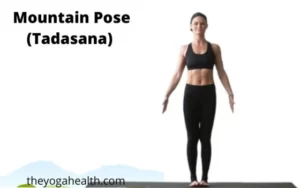Plow Pose (Halasana) is a graceful and transformative asana that offers a multitude of benefits for your body and mind. In this article we will delve into the step-by-step instructions to practice this Pose safely and effectively, as well as uncover its remarkable advantages.
Table of Contents
Plow Pose (Halasana)
‘Hala’ in the Sanskrit language means a ‘Plow’, as this pose resembles the shape of a plow, hence the name. Plow is a traditionally used agricultural tool in India which is used for digging the soil to prepare soil of the fields to grow crops. Halasana is part of the Sarvangasana and a continuation thereof.
Plow Pose (Halasana) Basic Details
| Sanskrit Name | Halasana |
| English Name | Plow Pose |
| Difficulty Level | Intermediate |
| Position | Supine |
Plow pose Yoga benefits following muscles:
- Upper Back muscles
- Middle Back muscles
- Lower Back muscles
- Hip muscles
- Hamstrings
- Neck muscles
Plow Pose Steps
1. First perform ‘Salamba Sarvangasana’ with a firm Chin lock.
2. Now release the chin lock, lower your trunk slightly and move your arms and legs over your head and rest the toes on the floor.
3. Tighten your knees, pull up your hamstring muscles at the back of your thighs, and raise your trunk.
4. Now place your hands on your back and press them to keep your trunk perpendicular to the floor.
5. Now stretch your arms on the floor in the opposite direction to that of the legs.
6. Now hook your trunks and fully stretch your arms and your legs.
7. Now interlock your fingers and turn your wrists so that your thumbs now rest on the floor. Now stretch your palms and fingers, tighten your arms at your elbows and pull them from your shoulders.
8. Your legs and your hands are stretched in opposite directions and your spine is completely stretched.
9. While interlocking the fingers, you should change your interlock every minute from right thumb on the floor to left thumb for harmonious development and elasticity of wrist, elbows, and shoulders.
Plow Pose Yoga Precautions
1. In the beginning interlocking of fingers is difficult but with regular practice, it can be achieved.
2. In the beginning keeping toes firmly on the floor will be difficult but if the people lengthen his Sarvangasana pose then the practitioner can also lengthen his stay in this asana.
3. You can perform this pose from 1 minute to 5 minutes as per your time and requirements.
4. For coming out of pose release your hands, raise your Sarvangasana pose, and slowly slide down on the floor. Now lie flat on the floor and relax for some time.
Plow Pose Benefits
This pose has following advantages
- Rejuvenates Abdominal Organs: This Pose works wonders for your abdominal organs as it involves a forward bend that creates a gentle contraction. This contraction stimulates and rejuvenates the abdominal organs, promoting better digestion and overall gut health.
- Relieves Backache: If you suffer from backache, this Pose can be a game-changer. In this asana, the forward bend stimulates an increase in blood flow to the spine, nourishing and healing the back as well as decreasing back pain.
- Cures Cramps in Hands: During this Pose, the interlocking and stretching of palms and fingers contribute to relieving cramps in the hands. People who frequently get hand cramps or stiffness may find this pose to be especially helpful.
- Eases Stiff Shoulders and Elbows: For those dealing with stiff shoulders and elbows, this Pose offers much-needed relief. The stretching involved in this asana helps to release tension and improve flexibility in these areas.
- Alleviates Arthritis and Lumbago: This Pose can be a soothing practice for individuals suffering from arthritis of the back and lumbago. The gentle stretch and relaxation provided by the asana can help reduce discomfort and promote better joint health.
- Relieves Stomach Pain: If you experience stomach pain caused by gas or indigestion, this Pose can provide quick relief. The pose aids in releasing trapped gas and promoting a sense of lightness in the stomach.
- Reduces Stress and Anxiety: As a forward bending pose, this Pose calms the nervous system, alleviating stress and anxiety, and inducing a sense of relaxation.
- Enhances Circulation and Vitality: By directing blood flow to the thyroid and parathyroid glands, this Pose stimulates these vital glands, which are responsible for regulating metabolism and energy levels.
Modification for Beginners
For beginners or those with limited flexibility, modifying Plow Pose can make the practice more accessible and enjoyable. Here are a few variations to consider:
- Half Plow Pose: Instead of lowering both legs behind your head, keep one leg on the ground while lifting the other leg towards the ceiling. This modification reduces strain on the neck and allows you to ease into the full pose gradually.
- Using Props: Place a folded blanket or yoga block under your shoulders for additional support. This can reduce the intensity of the stretch and make the pose more comfortable.
- Bent Knees: If straightening your legs in Plow Pose is challenging, you can bend your knees slightly. This modification lessens the pressure on the lower back and makes it easier to maintain the pose.
Plow Pose Variations and Transitions
Once you’ve become familiar with Plow Pose, you can explore various transitions and variations to deepen your practice. Some exciting options include:
- Plow Pose to Shoulder Stand: From Plow Pose, bend your elbows and place your hands on your lower back for support. Slowly lift your legs upward, transitioning into Shoulder Stand (Sarvangasana).
- Plow Pose with Lotus Legs: If you have a flexible hip joint, try bringing your legs into Lotus position while in Plow Pose. This advanced variation adds an extra challenge and enhances hip flexibility.
- Dynamic Plow Pose: Gently move in and out of Plow Pose with your breath. Inhale as you lift your legs up, and exhale as you release them back down. This dynamic flow adds a meditative element to your practice.
Preparatory Poses for Plow Pose
Building the Foundation
Preparing your body through a sequence of preparatory poses can enhance your Plow Pose experience and ensure safe alignment. Here are some excellent preparatory poses to consider:
- Bridge Pose (Setu Bandhasana): Bridge Pose helps to open the chest and shoulders while stretching the spine. It prepares your body for the deeper backbend in PlowPose.
- Shoulder Stand (Sarvangasana): Shoulder Stand is an inverted pose that strengthens the shoulders and neck, providing a strong foundation for the PlowPose.
- Seated Forward Bend (Paschimottanasana): This pose stretches the hamstrings and prepares your body for the forward bending action in PlowPose.
Follow-Up Poses for Deepening Your Practice
Extending the Benefits
After experiencing the revitalizing effects of Plow Pose, you can deepen your practice and integrate its benefits further with follow-up poses. Here are some follow-up poses that complement this Pose:
- Fish Pose (Matsyasana): Fish Pose counteracts the compression in the neck during Plow Pose and stretches the chest and throat. It opens the heart chakra and promotes relaxation.
- Child’s Pose (Balasana): Child’s Pose allows for a gentle stretch of the spine and relaxation after the inversions in Plow Pose. It provides a grounding and calming effect on the body and mind.
- Corpse Pose (Savasana): End your Plow Pose sequence with Corpse Pose to integrate the benefits and find stillness. Savasana allows your body and mind to assimilate the practice, promoting a sense of rejuvenation and peace.
Understanding the Limitations
While Plow Pose offers many benefits, it may not be suitable for everyone. Here are some contraindications and situations when you should avoid the pose:
- Neck and Spinal Injuries: If you have neck, back, or spinal injuries, refrain from practicing this Pose, as it can exacerbate the condition.
- Glaucoma: Inversions like Plow Pose can raise intraocular pressure, making it unsuitable for individuals with glaucoma.
- Avoid if Pregnant or with Medical Conditions: Pregnant women and individuals with any particular medical condition that require constant medical supervision should refrain from practicing this Pose. You can consult your medical healthcare provider before start doing this pose.
- Use Props for Support: If you’re new to this Pose or have limited flexibility, use props such as a folded blanket or yoga block under your shoulders for support.
- Engage Your Core: Throughout the pose, engage your core muscles to protect your lower back and provide stability to your body.
- Breathe Smoothly: Maintain steady and smooth breathing throughout the pose. Avoid holding your breath and allow it to flow naturally.
- Practice on an Empty Stomach: To avoid discomfort, practice this Pose on an empty stomach or at least 4-6 hours after a meal.
Conclusion:
Plow Pose (Halasana) is excellent for a person having a tendency for high blood pressure, if they perform this asana first before doing Sarvangasana, they will not feel rush of the blood in their head.
Halasana is a preparatory pose to Paschimottasana, improvement in this pose will also lead to performing Paschimottasana well with ease. As you continue to explore this Pose, let the asana guide you towards greater flexibility, strength, and peace of mind.
FAQ: Plow Pose
Q1. When should Halasana be avoided?
Ans: Pregnant women and women during menstruation should avoid this asana. People suffering from slip disc problem, injured cervical muscles, Sciatica problems, migraines, enlarged thyroid and spleen should also avoid this asana.
Q2. How long to hold Halasana?
Ans: You can perform this asana from 1 minute to 5 minutes as per your time and specific requirement.
Q3. Is Plow pose safe during pregnancy?
Ans: No this pose is not safe during pregnancy because lot of pressure comes on the stomach area so pregnant women and women during menstruation should avoid this Pose.
Do share your experience of this pose with other users of this site and share this article with your friends and family. If you have any questions regarding this Pose you can ask in the comments section below.





